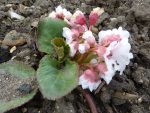
Also called fringed bergenia and hairy leaf bergenia, this herbaceous perennial is a member of the Saxifragaceae family that also includes foamflower (Tiarella), coral bells (Heuchera), and astilbe. It is found at higher elevations in the Himalayan region and in parts of Nepal, Pakistan, Afghanistan, Tibet, and China where it grows in woodlands, alpine meadows, and stone crevices of rocky slopes. Plants grow up to twelve inches tall from a rhizomatous rootstock and form rosettes of hairy leaves that are 9-24″ across, have toothed and fringed margins, and are almost circular. Panicles of fragrant pale pink flowers that darken with age appear in late spring. A slow growing plant, winter bergonia is a good choice for edgings, alpine and rock gardens, and cut flower. The generic name Bergenia honors the 18th century German physician and botanist Karl August von Bergen. The specific epithet, ciliata, comes from the Latin word cilium meaning eyelash, and refers to the hairs on the leaves, especially those on the margins.
Type: Herbaceous perennial
Bloom: Panicles of fragrant pale pink flowers in late spring
Size: 12″ H x 1.5″ W
Light:Part sun
Soil:Fertile, moderately moist, well-drained
Hardiness: Zones 6-10 (but does not tolerate high humidity)
Care: Low maintenance
Pests and Diseases: Generally healthy but susceptible to leaf spot, aphids, slugs, snails, weevils, and mealybugs
Propagation: Division of rhizomes; seed, but germination rate low
Companion Plants: Ferns, astilbe, bleeding heart, columbine
Photo Credit: Magnus Manske, Wikipedia